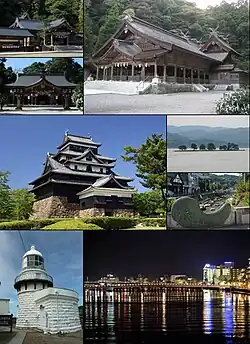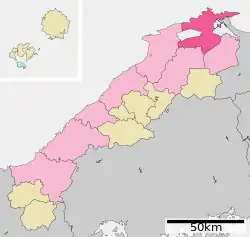Matsue
Matsue (Japanese: 松江市, Hepburn: Matsue-shi) is the capital city of Shimane Prefecture, Japan, located in the Chūgoku region of Honshu.[1][2] As of 31 March 2023, the city had an estimated population of 196,748 in 91287 households and a population density of 340 persons per km².[3] The total area of the city is 572.99 square kilometres (221.23 sq mi). Matsue is home to the Tokugawa-era Matsue Castle, one of the last surviving feudal castles in Japan.
Matsue
松江市 | |
|---|---|
 From top left: Kumano Taisha, Yaegaki Shrine, Miho Shrine, Matsue Castle, Lake Shinji (Yomegashima), Tamatsukuri hot springs, Mihonoseki Lighthouse, Night view of Matsue | |
 Flag  Emblem | |
Location of Matsue in Shimane Prefecture | |
 | |
 Matsue Location in Japan | |
| Coordinates: 35°28′05″N 133°02′55″E | |
| Country | Japan |
| Region | Chūgoku (San'in) |
| Prefecture | Shimane |
| Government | |
| • Mayor | Uesada Akihito (since April 2021) (Ind.) |
| Area | |
| • Total | 572.99 km2 (221.23 sq mi) |
| Population (March 31, 2023) | |
| • Total | 196,748 |
| • Density | 340/km2 (890/sq mi) |
| Time zone | UTC+09:00 (JST) |
| City hall address | 86 Suetsugu, Matsue-shi, Shimane-ken 690-8540 |
| Climate | Cfa |
| Website | Official website |
| Symbols | |
| Flower | Camellia, Peony |
| Tree | Pinus, Cherry blossom |
Geography
Matsue is located at the northernmost point of Shimane Prefecture, between Lake Shinji and Nakaumi on the banks of the Ohashi River connecting the two lakes, though the city proper reaches the Sea of Japan coast. Matsue is the center of the Lake Shinji-Nakaumi metropolitan area, which has a population of approximately 600,000 in 2020. The Lake Shinji-Nakaumi metropolitan area is the fourth largest on the Sea of Japan coast after Niigata, Greater Kanazawa, and Fukui.[4]
Climate
Matsue has a humid subtropical climate (Köppen climate classification Cfa) with very warm summers and cool winters. Precipitation is abundant throughout the year, and is somewhat heavier in June, July and September. The average annual temperature in Matsue is 15.2 °C (59.4 °F). The average annual rainfall is 1,791.9 mm (70.55 in) with July as the wettest month. The temperatures are highest on average in August, at around 27.1 °C (80.8 °F), and lowest in January, at around 4.6 °C (40.3 °F).[5] The highest temperature ever recorded in Matsue was 38.5 °C (101.3 °F) on 1 August 1994; the coldest temperature ever recorded was −8.7 °C (16.3 °F) on 19 February 1977.[5]
| Climate data for Matsue (1991−2020 normals, extremes 1940−present) | |||||||||||||
|---|---|---|---|---|---|---|---|---|---|---|---|---|---|
| Month | Jan | Feb | Mar | Apr | May | Jun | Jul | Aug | Sep | Oct | Nov | Dec | Year |
| Record high °C (°F) | 20.6 (69.1) |
24.7 (76.5) |
26.4 (79.5) |
30.7 (87.3) |
32.4 (90.3) |
35.0 (95.0) |
37.1 (98.8) |
38.5 (101.3) |
36.1 (97.0) |
32.1 (89.8) |
27.4 (81.3) |
23.2 (73.8) |
38.5 (101.3) |
| Average high °C (°F) | 8.3 (46.9) |
9.4 (48.9) |
13.1 (55.6) |
18.5 (65.3) |
23.2 (73.8) |
26.2 (79.2) |
29.8 (85.6) |
31.6 (88.9) |
27.1 (80.8) |
22.0 (71.6) |
16.5 (61.7) |
10.9 (51.6) |
19.7 (67.5) |
| Daily mean °C (°F) | 4.6 (40.3) |
5.0 (41.0) |
8.0 (46.4) |
13.1 (55.6) |
18.0 (64.4) |
21.7 (71.1) |
25.8 (78.4) |
27.1 (80.8) |
22.9 (73.2) |
17.4 (63.3) |
12.0 (53.6) |
7.0 (44.6) |
15.2 (59.4) |
| Average low °C (°F) | 1.5 (34.7) |
1.3 (34.3) |
3.6 (38.5) |
8.2 (46.8) |
13.5 (56.3) |
18.2 (64.8) |
22.8 (73.0) |
23.8 (74.8) |
19.6 (67.3) |
13.4 (56.1) |
8.0 (46.4) |
3.6 (38.5) |
11.4 (52.5) |
| Record low °C (°F) | −6.9 (19.6) |
−8.7 (16.3) |
−4.7 (23.5) |
−2.1 (28.2) |
2.4 (36.3) |
7.8 (46.0) |
12.9 (55.2) |
15.3 (59.5) |
7.9 (46.2) |
1.6 (34.9) |
−2.4 (27.7) |
−7.5 (18.5) |
−8.7 (16.3) |
| Average precipitation mm (inches) | 153.3 (6.04) |
118.4 (4.66) |
134.0 (5.28) |
113.0 (4.45) |
130.3 (5.13) |
173.0 (6.81) |
234.1 (9.22) |
129.6 (5.10) |
204.1 (8.04) |
126.1 (4.96) |
121.6 (4.79) |
154.5 (6.08) |
1,791.9 (70.55) |
| Average snowfall cm (inches) | 28 (11) |
25 (9.8) |
6 (2.4) |
0 (0) |
0 (0) |
0 (0) |
0 (0) |
0 (0) |
0 (0) |
0 (0) |
0 (0) |
11 (4.3) |
68 (27) |
| Average precipitation days (≥ 0.5 mm) | 21.1 | 16.9 | 15.0 | 11.6 | 10.4 | 12.0 | 12.7 | 10.6 | 12.6 | 12.0 | 14.9 | 19.8 | 169.7 |
| Average relative humidity (%) | 76 | 74 | 72 | 70 | 71 | 78 | 80 | 77 | 79 | 76 | 76 | 76 | 75 |
| Mean monthly sunshine hours | 67.4 | 88.6 | 140.5 | 182.4 | 206.5 | 157.1 | 168.6 | 201.0 | 146.2 | 154.4 | 113.8 | 78.8 | 1,705.2 |
| Source: Japan Meteorological Agency[5] | |||||||||||||
| Climate data for Kashima, Matsue (1991−2020 normals, extremes 1978−present) | |||||||||||||
|---|---|---|---|---|---|---|---|---|---|---|---|---|---|
| Month | Jan | Feb | Mar | Apr | May | Jun | Jul | Aug | Sep | Oct | Nov | Dec | Year |
| Record high °C (°F) | 19.3 (66.7) |
22.7 (72.9) |
24.7 (76.5) |
29.3 (84.7) |
31.8 (89.2) |
35.1 (95.2) |
36.8 (98.2) |
37.5 (99.5) |
35.8 (96.4) |
31.7 (89.1) |
26.8 (80.2) |
22.2 (72.0) |
37.5 (99.5) |
| Average high °C (°F) | 8.3 (46.9) |
9.1 (48.4) |
12.5 (54.5) |
17.8 (64.0) |
22.5 (72.5) |
25.6 (78.1) |
29.1 (84.4) |
30.7 (87.3) |
26.7 (80.1) |
21.8 (71.2) |
16.5 (61.7) |
11.1 (52.0) |
19.3 (66.8) |
| Daily mean °C (°F) | 4.8 (40.6) |
5.0 (41.0) |
7.7 (45.9) |
12.5 (54.5) |
17.4 (63.3) |
21.1 (70.0) |
25.1 (77.2) |
26.3 (79.3) |
22.3 (72.1) |
16.9 (62.4) |
11.8 (53.2) |
7.1 (44.8) |
14.8 (58.7) |
| Average low °C (°F) | 1.3 (34.3) |
0.9 (33.6) |
2.6 (36.7) |
6.9 (44.4) |
12.3 (54.1) |
17.3 (63.1) |
21.8 (71.2) |
22.6 (72.7) |
18.4 (65.1) |
12.3 (54.1) |
7.4 (45.3) |
3.4 (38.1) |
10.6 (51.1) |
| Record low °C (°F) | −6.6 (20.1) |
−9.9 (14.2) |
−4.5 (23.9) |
−2.3 (27.9) |
2.5 (36.5) |
9.1 (48.4) |
12.3 (54.1) |
14.7 (58.5) |
7.3 (45.1) |
3.0 (37.4) |
−0.8 (30.6) |
−3.5 (25.7) |
−9.9 (14.2) |
| Average precipitation mm (inches) | 143.7 (5.66) |
108.0 (4.25) |
124.9 (4.92) |
105.6 (4.16) |
121.5 (4.78) |
166.9 (6.57) |
224.8 (8.85) |
136.4 (5.37) |
198.9 (7.83) |
122.6 (4.83) |
131.8 (5.19) |
157.7 (6.21) |
1,742.8 (68.61) |
| Average precipitation days (≥ 1.0 mm) | 18.4 | 14.4 | 13.2 | 9.8 | 9.1 | 10.7 | 11.8 | 9.5 | 11.5 | 10.6 | 13.4 | 17.9 | 150.3 |
| Mean monthly sunshine hours | 55.8 | 81.0 | 142.1 | 192.4 | 215.8 | 163.8 | 181.6 | 214.9 | 156.9 | 157.8 | 105.8 | 67.1 | 1,735.1 |
| Source: Japan Meteorological Agency[6][7] | |||||||||||||
Demographics
Per Japanese census data, the population of Matsue in 2020 is 203,616 people.[8] Matsue has been conducting censuses since 1920.
|
|
| ||||||||||||||||||||||||||||||||||||||||||||||||||||||||||||||||||||||||
| Matsue population statistics[8] | ||||||||||||||||||||||||||||||||||||||||||||||||||||||||||||||||||||||||||
History
Matsue is located within ancient Izumo Province and there are many archaeological sites from the Yayoi, Kofuns and Nara periods within the city borders. The area was also the stronghold of the Amago clan during the Sengoku period. The present-day castle town of Matsue was originally established by Horio Yoshiharu, lord of the Matsue clan, when he built Matsue castle and planned the surrounding town over a five-year period from 1607 to 1611. Matsue continued to be the seat of Matsue Domain under the Tokugawa shogunate until the Meiji restoration. Horio Yoshiharu's son Tadauji died before his father, thus the province was inherited by his grandson Tadaharu. However, Tadaharu died childless so the province was passed on to the Kyōgoku. Kyōgoku Takatsugu served Oda Nobunaga and Toyotomi Hideyoshi. Takatsugu's son Tadataka married the 4th daughter of Hidetada, Hatsu. He served in the Battle of Osaka and reportedly took 300 heads. In 1634, he received the province of Izumo, succeeding the childless Horio Tadaharu. During his rule he was instrumental in engineering projects that helped control the flow of the Hiikawa river.
In 1637, Tadataka also died childless and the domain passed to the Matsudaira clan. Naomasa was the third son of Tokugawa Hideyasu. Hideyasu, daimyō of Echizen Province, himself was the second son of Tokugawa Ieyasu, making Naomasa the grandson of the first Tokugawa Shōgun. Naomasa made a name for himself fighting in the Battle of Osaka at the age of 14. He was daimyō of Ono in Echizen and later Matsumoto in Shinano Province before becoming the ruler of Izumo 1638. Unlike the previous rulers Naomasa had children and his heirs managed to keep Izumo for ten generations until the end of the Edo period. Overall, ten Matsudaira daimyō ruled Matsue. The most famous after the first (Matsudaira Naomasa) is the seventh, Matsudaira Harusato, more commonly referred to as Fumai (不昧公).[9] He revolutionized the administrative system of the Matsue clan which was in financial difficulties and put it back on its feet. He invested in mulberry bushes and promoted special foods like shijimi clams that were a delicacy in Matsue. Harusato was a great enthusiast of Japanese tea ceremony. Because his influence on wagashi, Japanese sweets for the tea ceremony from Matsue are famous, especially one called wakakusa.
Municipal timeline
- April 1, 1889: the city of Matsue was founded with the creation of the modern municipalities system
- March 31, 2005: Matsue absorbed the towns of Kashima, Mihonoseki, Shimane, Shinji, Tamayu and Yatsuka, and the village of Yakumo, all from Yatsuka District, to create the new and expanded city of Matsue.
- August 1, 2011: the town of Higashiizumo (also from Yatsuka District) was merged into Matsue.[10]
- April 1, 2018: Matsue became a Core city with increased local autonomy
Government
Matsue has a mayor-council form of government with a directly elected mayor and a unicameral city council of 34 members. Matsue conributes 11 members to the Shimane Prefectural Assembly. In terms of national politics, the city is part of the Shimane 1st district of the lower house of the Diet of Japan.
Economy
Matsue is a major regional commercial center and as one of the base cities of the San'in region, and along with Yonago, there are many head offices of companies operating in the San'in region. Agriculture, commercial fishing and tourism play major roles in the local economy; however, the city has only a small industrial base.
Education
Universities and colleges
- Shimane University
- Matsue College of Technology
- University of Shimane Junior College
Primary and secondary education
Matsue has 33 public elementary school, 17 public junior high schools and one public high school operated by the city government, and seven public high schools operated by the Shimane Prefectural Board of Education. The prefecture operates five special education schools for the handicapped. There are also four private high schools.
Transportation
Railway
![]() JR West (JR West) - San'in Main Line
JR West (JR West) - San'in Main Line
- Shinji - Kimachi - Tamatsukuri-Onsen - Nogi - Matsue - Higashi-Matsue - Iya
![]() JR West (JR West) - Kisuki Line
JR West (JR West) - Kisuki Line
![]() Ichibata Electric Railway (Bataden) - Kita-Matsue Line
Ichibata Electric Railway (Bataden) - Kita-Matsue Line
International relations
International Friendship Cities[11]
 New Orleans, Louisiana, United States, 1990 (commenced)/1994 (official agreement)
New Orleans, Louisiana, United States, 1990 (commenced)/1994 (official agreement) Jilin City, Jilin, China, 1995 (commenced)/1999 (official agreement)
Jilin City, Jilin, China, 1995 (commenced)/1999 (official agreement) Jinju, South Gyeongsang, South Korea, 1999 (official agreement)
Jinju, South Gyeongsang, South Korea, 1999 (official agreement) Hangzhou, Zhejiang, China, 1994 (commenced)/2003 (official agreement)
Hangzhou, Zhejiang, China, 1994 (commenced)/2003 (official agreement) Yinchuan, Ningxia, China, 1994 (commenced)/2004 (official agreement)
Yinchuan, Ningxia, China, 1994 (commenced)/2004 (official agreement)
Local attractions
- Matsue Castle, s one of the 12 remaining original castles in Japan. It is the second largest, the third tallest and the sixth oldest. The castle grounds include a winding path through mixed forests of bamboo, shrubs and trees, many of which are very old and identified by species. Surrounding the grounds and the castle park is the old moat, "horikawa".
- Lafcadio Hearn Memorial Museum, dedicated to the author Lafcadio Hearn, who taught in Matsue from 1890–1891. Throughout the city there are monuments and landmarks honouring Hearn.
- Shimane Art Museum
- Tanabe Art Museum.
- Sada Jinja in Matsue is the home to Sada Shin Noh, a sacred dance comprising a series of purification rituals related to the changing of the rush mats within the shrine. The mats are held by dancers who then offer them to deities to sit upon. Diverse dance forms are performed on a stage in the shrine accompanied by singing, flute and drums. The performance art is transmitted from generation to generation by the community. In November 2011, Sada Shin Noh was inscribed on the UNESCO Representative List of the Intangible Cultural Heritage of Humanity.[14]
- Yaegaki Jinja
- Kumano Taisha, ichinomiya of Izumo Province
- Kamosu Jinja,
- Miho Jinja
- Izumo Kokubun-ji rruins, an National Historic Site.[15]
- Tamatsukuri Onsen
Noted people from Matsue
- Takashi Nagai, physician, Catholic priest
- Kei Nishikori (b. 1989), tennis player, was born in Matsue.
- Wakatsuki Reijirō, former Prime Minister
- Hiroyuki Hosoda, politician
- Shirō Sano, actor
References
- Nussbaum, Louis-Frédéric. (2005). "Matsue" in Japan Encyclopedia, p. 617; "Chūgoku" at p. 127.
- Japan National Tourism Organization (JNTO), "Matsue area"; retrieved 2012-2-11.
- "Matsue City official statistics" (in Japanese). Japan.
- 中海・宍道湖圏域の概要 at the Wayback Machine (archived July 23, 2023)
- 気象庁 / 平年値(年・月ごとの値). Japan Meteorological Agency. Retrieved May 19, 2021.
- 観測史上1~10位の値(年間を通じての値). JMA. Retrieved April 26, 2022.
- 気象庁 / 平年値(年・月ごとの値). JMA. Retrieved April 26, 2022.
- Matsue population statistics
- https://fumaikou.jp/about
- 松江市が人口「最下位」を返上 (in Japanese). Sanin-Chūō Shimbun. Archived from the original on 2010-12-24. Retrieved 2011-03-21.
- "松江市:市政情報:海外の姉妹都市".
- "松江市:市政情報:姉妹都市".
- "松江市:市政情報:アイルランド".
- "Sada Shin Noh, sacred dancing at Sada shrine, Shimane". UNESCO. Retrieved 31 January 2012.
- "Izumo Kokunbunji". Agency for Cultural Affairs. Retrieved 31 January 2012.
- "松江市鼕行列保存会 - 鼕と鼕行列の歴史".
- "松江の船神事「ホーランエンヤ」 開催周期10年に短縮". 5 August 2010.